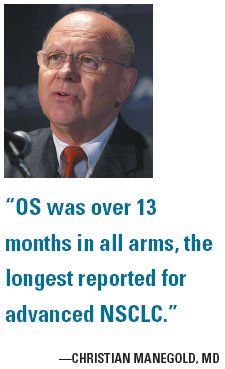Final AVAiL results confirm longer PFS with bevacizumab
STOCKHOLM-Final analysis of the phase III Avastin in Lung Study (AVAiL), which evaluated bevacizumab (Avastin) as first-line therapy for advanced nonsmall- cell lung cancer, showed that adding bevacizumab to gemcitabine/cisplatin significantly extends progression-free survival, Christian Manegold, MD, of Heidelberg University in Mannheim, Germany, reported at ESMO 2008 (abstract LBA1).
ABSTRACT: Most cases of advanced nonsmall- cell lung cancer benefit from Avastin addition
STOCKHOLM-Final analysis of the phase III Avastin in Lung Study (AVAiL), which evaluated bevacizumab (Avastin) as first-line therapy for advanced nonsmall- cell lung cancer, showed that adding bevacizumab to gemcitabine/cisplatin significantly extends progression-free survival, Christian Manegold, MD, of Heidelberg University in Mannheim, Germany, reported at ESMO 2008 (abstract LBA1).
“These results support bevacizumabbased therapy as a first-line standard of care in the vast majority of eligible patients,” Dr. Manegold said.

AVAiL randomized 1,050 patients with stage IIIB/IV or recurrent nonsquamous NSCLC to cisplatin 80 mg/m2 plus gemcitabine 1,250 mg/m2 with or without bevacizumab (7.5 mg/kg or 15 mg/kg) until progression. Patients who did not progress could continue bevacizumab as maintenance therapy.
At 12.5 months of follow-up, progression- free survival was signifi cantly improved with bevacizumab, from 6.2 months in the placebo arm to 6.8 months with the 7.5 mg/kg dose (P = .0003) and to 6.6 months with the 15 mg/kg dose (P = .0456), Dr. Manegold reported.
No differences were observed in overall survival. However, “OS was remarkably long in all arms, over 13 months, which is the longest reported for advanced NSCLC,” Dr. Manegold said.
The lack of difference in OS is most likely due to second-line treatment infl uences, he said. Two-thirds of patients in each arm received post-protocol therapy. In the minority of patients not receiving further treatment (n = 123), there was a trend toward improved OS with bevacizumab, 8.7 months vs 7.3 months, translating into a 16% reduction in risk.
Commentary
Unlike ECOG 4599 (N Engl J Med 355:2542-2550, 2006), the AVAiL study did not show a significant improvement in overall survival with bevacizumab, compared with controls, and the risk of progression was reduced by 15% to 25% (depending on bevacizumab dose), compared with 34% in ECOG 4599, said Jean-Charles Soria, MD, professor of medicine at Institut Gustave Roussy in Villejuif, France. However, in all arms, overall survival was the longest observed yet in a clinical trial of this regimen (13.1 months), and progression-free survival was among the longest (6.8 months), he noted.
Dr. Soria attributed the lack of a difference in OS to the abundance of patients with good prognostic factors at baseline and a “too good” placebo arm.
“AVAiL had a very high percentage of never-smokers (24%), and data increasingly suggest that prognosis is better in this population,” he said.
The cohort also included a high proportion of adenocarcinoma (85%) and a low proportion of stage IIIB dry (without pleural effusion) patients (7%). He also cited the infl uence of second-line treatment. Importantly, 65% of patients in AVAiL went on to second-line therapy, compared with 29% to 56% in previous studies.
Dr. Soria attributed the lack of a difference in OS to the abundance of patients with good prognostic factors at baseline and a “too good” placebo arm. “AVAiL had a very high percentage of never-smokers (24%), and data increasingly suggest that prognosis is better in this population,” he said.
The cohort also included a high proportion of adenocarcinoma (85%) and a low proportion of stage IIIB dry (without pleural effusion) patients (7%). He also cited the influence of second-line treatment. Importantly, 65% of patients in AVAiL went on to second-line therapy, compared with 29% to 56% in previous studies.
Dr. Soria concluded that bevacizumab and chemotherapy should be considered a standard of care but not mandatory. “The extent of this triplet therapy is in the same range as the best doublet chemotherapy in the non-squamous-cell population,” he said.
He advised combining bevacizumab with a doublet that has been validated in phase III trials and avoiding doublets whose safety has not been confirmed (pemetrexed/cisplatin). The dose should be based on the backbone chemotherapy, with 15 mg/kg recommended with paclitaxel/ carboplatin and 7.5 mg/kg with gemcitabine/cisplatin.
Eric Ko on Combining Radiation Therapy With Immunotherapy to Treat Non–Small-Cell Lung Cancer
September 18th 2018ONCOLOGY spoke with Eric Ko, MD, PhD, who recently published a review article with his colleagues on strategies for combining radiation therapy with immunotherapy for the treatment of non–small-cell lung cancer.